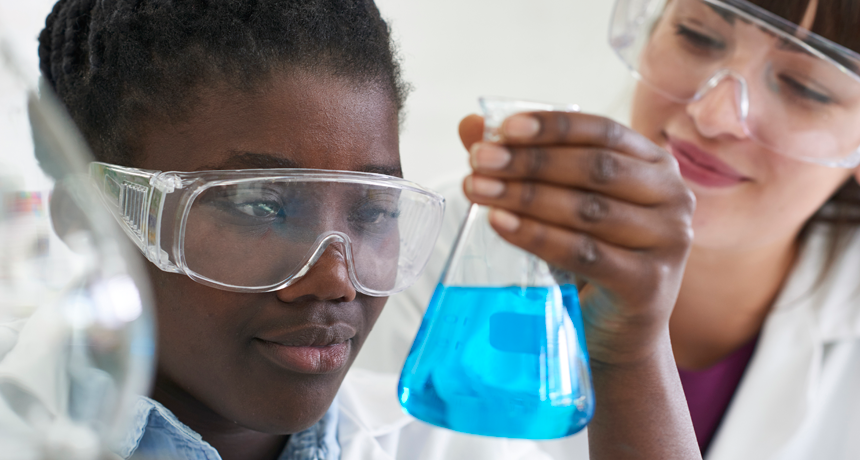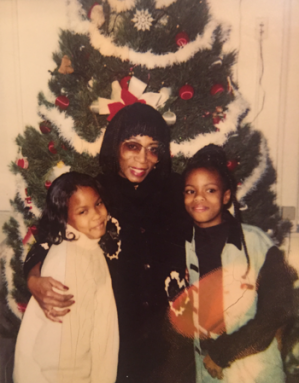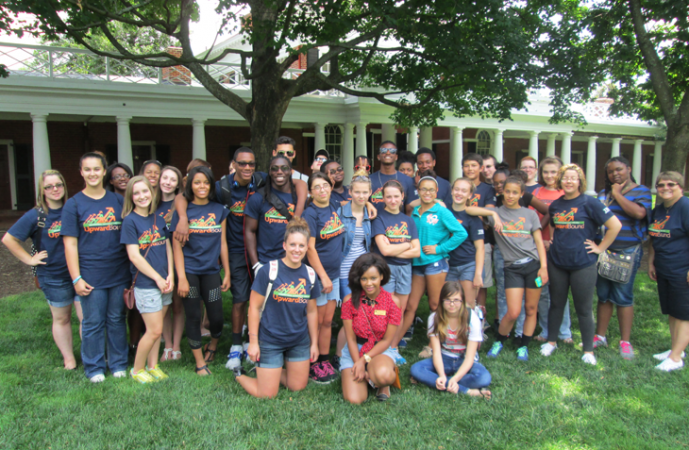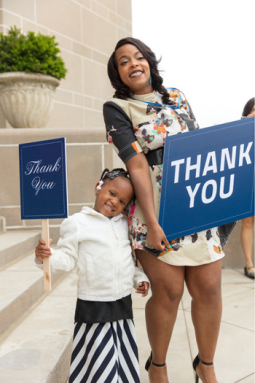Enriching opportunities can point teens toward a STEM career
Programs from middle school on up help students stay on track in science and tech

Science offers students a host of ways to explore their world. But money troubles may keep some kids from considering a career in STEM. Most don’t realize there are scores of programs available to help them get the education and training for such jobs.
MachineHeadz/iStockphoto
Growing up in Cleveland, Ohio, Shanina Knighton had to deal with poverty, domestic violence and homelessness. She also attended struggling public schools. In fact, last year the Ohio education department’s report card for school districts gave her home town’s public schools an embarrassing F. Still, none of these obstacles kept Knighton from a career in STEM — science, technology, engineering and math.
She hurdled a host of obstacles to become a nurse scientist. She is the first member of her family to attend college. And she didn’t stop there. She got a PhD. Today, she’s still in her home town area, working at Case Western Reserve University. There, she focuses on how to improve patient care.
In one recent study, for instance, her team showed that verbal, audio messages got elderly hospital patients to clean their hands more often. The American Journal of Infection Control published those findings on March 1, 2018.
Knighton had to work very hard to get where she is. And she didn’t do it alone. Like many students, she took advantage of resources available to those in need. Some students need money. Others need help learning how to study effectively. Still others need emotional support or help identifying which of the many STEM fields in which they might want to work. Some students might even need help with all of the above. Fortunately, most students will have access to some outside resources. They just need to know where to look or what to ask.
Here are some links to resources that can help students get started.
Got problems? Open up to someone

Students can’t focus on their studies, much less their future, if they’re worried about how to make it through the next day or week. Knighton suggests that they focus on what might be an obstacle to their performing well. Is money tight? Is reading or some health issue interfering with their studies? Is neighborhood safety a concern? Are tensions at home a distraction?
Knighton faced a series of these. And for a long while, she didn’t feel that she could talk about them. She was living in a shelter at the time. Her family was broke. She was excited to be on her school’s drill team. But then she learned that all team members had to get competition shoes. Unable to afford them, Knighton decided she’d just have to quit the team. When her coach asked why, “I just broke down and told her everything that had happened in the past couple of months,” she recalls.
The girl had options, that coach pointed out. Working through them, Knighton was able to stay on the team. This first success led her to reach out again. And again. Schools have many teachers, administrators, coaches and counselors who would be happy to help. But they can’t if a student doesn’t speak up.
Gearing up
One U.S. Department of Education program recruits students in middle school to get ready for college. The program is called Gaining Early Awareness and Readiness for Undergraduate Programs, or GEAR UP.
GEAR UP funds groups of students to work together into and through high school. Over six years, the students learn study skills. They may take STEM-related field trips. They can visit colleges, which can sometimes seem like a big mystery for students who will be the first in their family to go away to school. Ask if your school takes part.
Other groups may focus on a teen’s special interest. For example, Girls Who Code, Open World Learning and other groups teach computer skills. Or find a local makerspace. These are places within many communities where people — including young students — can work to build skills and confidence and become comfortable with technologies (such as computing or robotics). Fab Foundation offers links to a nationwide network.
The U.S. Department of Education also runs an Upward Bound program. It focuses on helping students from low income families, or ones whose parents never graduated from college. Knighton took part. It provides classes in math, sciences, English and foreign languages. It also offers tutoring, counseling, mentoring, cultural enrichment and work-study programs. The program can even arrange college visits and help teens apply for aid to pay for college. Through this program, Knighton got a chance to take a class over the summer at a local university.
Story continues below image.

Upward Bound’s Math and Science Program offers specialized training for teens interested in STEM. It also targets students from groups that have not traditionally attended college in high numbers. These include students with disabilities, those who are homeless, those in foster care or groups who are otherwise “disconnected” from the normal college-bound community. This program offers extra training in math, science and computer skills. Students can meet college faculty. Some high-school students may even get introductions to people with whom they might work on research at a nearby college.
Programs in several states run by MESA — Mathematics Engineering Science Achievement — also help groups of students from middle school through their college years. For more than 40 years, this program has turned out high-school graduates who are well-trained in math by providing extra “classes, hands-on competitions, counseling, transfer support and a community environment to students.”
Another three-year program, Minds Matter, prepares low-income high-school students in 14 major U.S. cities for college. Its website says that so far all of the program’s graduates have been accepted to four-year colleges.
Help follows some students to college
Despite working hard in high school, Knighton failed her first test in college. She hadn’t goofed off. She just wasn’t prepared.
“I went to my professor and said I need to know what I have to do to be able to pass this course,” Knighton recalls. Her school, Baldwin Wallace University in Berea, Ohio, was one of many that offer tutoring. The teen took advantage of this help and worked even harder. She passed the class and did better in later courses.
The U.S. Department of Education offers eight programs aimed at helping first-generation college students, those with disabilities and those who come from low-income families. One of these programs, Student Support Services, offers tutoring in specific courses. It also fosters study skills. Participants learn to master time management. And they meet with advisors regularly.

“We don’t want you to go to tutoring when you’re failing a course,” stresses George Bovell. He heads Student Support Services at Cleveland State University in Ohio. “We want you to go to tutoring to keep up.”
College also can be a time of stress as students learn to live away from home and manage their lives as young adults. Having a support group can help. Such groups connect students facing similar issues and let them bond over common interests or work to overcome common challenges.
Knighton found kindred spirits in her school’s gospel choir and in the Black Student Alliance. Other students may join SACNAS, the Society for Advancement of Chicanos/Hispanics and Native Americans in Science. It has campus programs and holds conferences, too.
“Seeing someone that looks like you helps a lot,” says Omar Villanueva. He’s a chemistry professor at Georgia Gwinnett College in Lawrenceville.
Many students at his college struggle financially. He understands their plight. He, too, grew up poor. “My parents had to work multiple jobs for us to just keep up with bills and rent,” he recalls.
Fortunately, many students can find jobs on campus to help pay their bills. Some of that work may even be doing science in a university lab. Now, Villanueva notes, “they don’t have to have a second or third job on the side that will prevent them from finishing their degree.” One added benefit: On-campus research experience can help students in STEM who want to go on to graduate school.
Some of these programs won’t apply to you. Some may not even be available in your community. But don’t despair. This list suggests the types of programs that are widely available. One of them — or something similar — might just make all the difference in whether you can advance to a rewarding career in science, tech, engineering or math.
This is part of a Cool Jobs series on the value of diversity in science, technology, engineering and mathematics. It has been made possible with generous support from Arconic Foundation.







